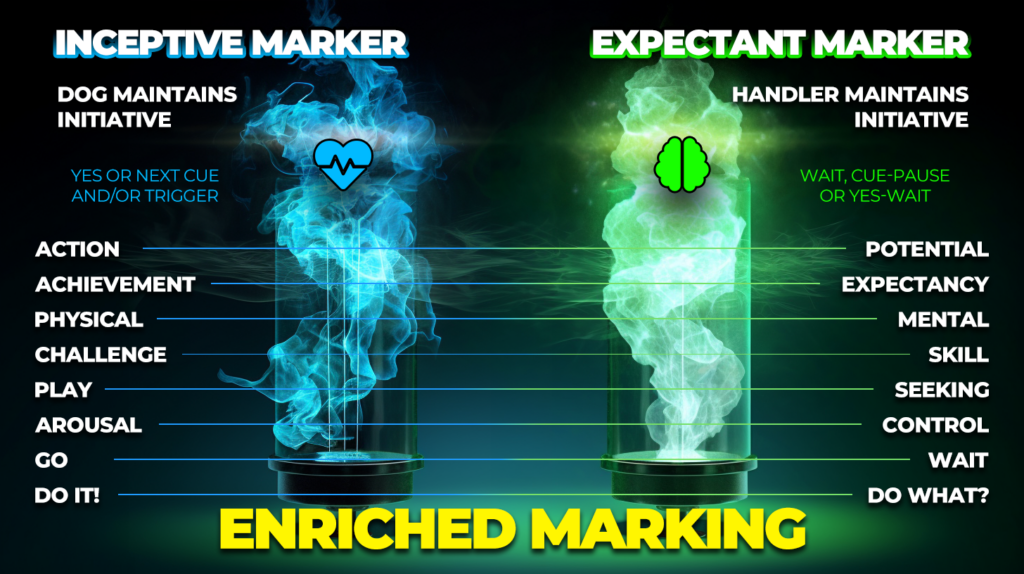
Shape the Classical Condition and Maintain and Manage Operant Drive with Enriched Marking | a Play+ Sneak Peek
A textbook positive marker, always followed by a discrete cookie is an initiative transfer from handler to dog.
When a traditional positive marker is given, directly followed by a discrete cookie the dog has satisfied the process, achieved the subjective aim, and seized the initiative: Carpe CookieA Cookie is traditionally thought of as a food treat given as positive reinforcement. In that definition, a cookie is a discrete piece of food reinforcement. In many dog training discussions, the idea... More!
Enriched Marking via Play+ allows markers to be given without ceding initiative and also allows the Dog | Handler | Team to shape a desired classically conditioned tone and to build, manage, and maintain drive and engagement.
Enriched Marking with Inceptive and Expectant Markers creates a dynamic communication system that takes advantage of the dipolar mental-physical pole structure of Play+ allowing the handler to increase or reduce the challenge, focus on the skill, or manage drive simply by choosing how the cookie happens after the marker.

Expectant Markers – Mental Pole
In the Play+ methodology, expectant markers are a form of communication between the handler and the dog that serve to both acknowledge a performed behavior and indicate that another behavior or opportunity is imminent. They create an expectancy within the dog for the next piece of interaction. An expectant marker is not a reward in itself but rather an assurance that the desired opportunity for play or work is coming. It’s a way of saying, “Good job, now get ready for what’s next!” This creates expectancy in the dog to resolve the ambiguity and keeps them engaged and eager to achieve the next part of the game or training session. This proves that Next"Next" encapsulates the dog's anticipation of a forthcoming reward, sparking motivation and excitement. This expectancy creates a driving force that propels the dog through training, forming a continuous loop of engagement. When "Next"... More! is a cookie.
To deliver an Expectant Marker An expectant marker in Play+ is a signal, either a cue or a positive marker, used by the handler during training to create a sense of expectancy or anticipation in the dog. It... More, simply give your positive marker (or a wait as a marker) and pause until you get Attention
An expectant marker in Play+ is a signal, either a cue or a positive marker, used by the handler during training to create a sense of expectancy or anticipation in the dog. It... More, simply give your positive marker (or a wait as a marker) and pause until you get Attention Unsolicited eye contact or Attention is a great way to hook up with a dog. If you have something the dog wants he should give eye contact in order to get access to... More. Reinforce Attention with the next cue, trigger, or discrete cookie. That’s it.
Unsolicited eye contact or Attention is a great way to hook up with a dog. If you have something the dog wants he should give eye contact in order to get access to... More. Reinforce Attention with the next cue, trigger, or discrete cookie. That’s it.
Experience Initiative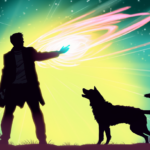 In the context of Play+, initiative encapsulates the process of leading the dynamic interaction during play. Whether it's the Dog or the Handler, the one with the initiative actively guides the direction of... More Transfers
In the context of Play+, initiative encapsulates the process of leading the dynamic interaction during play. Whether it's the Dog or the Handler, the one with the initiative actively guides the direction of... More Transfers
The Expectant Marker maintains the Handler’s initiative and teaches the dog how to pass the initiative off to the handler at the appropriate time or when the team’s aim is unknown.
For example, in the game of “This, Wait… Next!”, the “Wait” serves as an expectant marker. It is delivered when the feet hit the pedestal Spot is a “go to a place”, or “go to a mat” behavior. This means that the dog seeks out and performs a duration behavior on a spot of the handler’s choosing. A... More, as a marker. Wait
Spot is a “go to a place”, or “go to a mat” behavior. This means that the dog seeks out and performs a duration behavior on a spot of the handler’s choosing. A... More, as a marker. Wait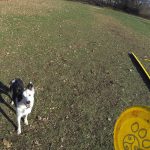 Waiting on cue and situationally is extremely important for disc dog freestyle training. The competition field might not see too much waiting going on as everything is supposed to be happening in flow,... More is a potential Trigger. So what’s gonna happen?
Waiting on cue and situationally is extremely important for disc dog freestyle training. The competition field might not see too much waiting going on as everything is supposed to be happening in flow,... More is a potential Trigger. So what’s gonna happen?
The handler wait’s for Attention. This creates a moment of Aporia, a cooperative impasse, that the dog resolves by looking to the handler and achieves the presentation of the next behavior or opportunity. This pause generates expectancy, an expectancy for what’s next that needs to be resolved.
Inceptive Markers – Physical Pole
Derived from the Latin “incipere,” meaning to grasp, take to hand, or begin, “Inceptive” captures the idea of a marker that communicates the successful achievement of the pieces of behavior while allowing us to grasp it or bring them ready-to-hand. Inceptive Marking signals the beginning of Next in the successful termination of Now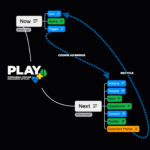 The Now Phase is an integral part of the Play Cycle in the Play+ training philosophy. It embodies the current, immediate interaction between the handler and the dog, anchoring them in the present... More.
The Now Phase is an integral part of the Play Cycle in the Play+ training philosophy. It embodies the current, immediate interaction between the handler and the dog, anchoring them in the present... More.
When the dog-handler team is performing at its best, the details of their actions and behaviors become transparent – both to them and to observers. This transparency makes it difficult to analyze and understand what exact elements are contributing to the success. It’s as if the performance becomes a seamless, undifferentiated flow where individual actions and behaviors merge into a coherent whole. This poses Posing is a communication tool for throwing discs to dogs (or people). A pose is a frozen moment of a throw; a key moment of the backswing perhaps, or a flashy presentation of... More a challenge for training as it becomes harder to isolate and replicate these successful elements.
Posing is a communication tool for throwing discs to dogs (or people). A pose is a frozen moment of a throw; a key moment of the backswing perhaps, or a flashy presentation of... More a challenge for training as it becomes harder to isolate and replicate these successful elements.
To deliver an Inceptive Marker, simply mark a key criteria in the chain and reinforce with the next behavior in the chain or a consequent presentation of the next cue.
Inceptive Marking: Making Things Ready-to-Hand and Ready-to-Paw
By highlighting key actions and moments, inceptive marking acts as a guide, bringing skills and behaviors ready-to-hand for the handler and ready-to-paw for the dog. The use of inceptive markers directs the focus of both handler and dog to the important aspects of performance, fostering a deeper understanding of the sequence and purpose of each behavior in a chain. This anticipatory marking cultivates a shared rhythm in the play, enriching the cooperative aspect of the Dog | Handler | Team dynamic and supporting the continued development of skills.
Same Old Marker – Novel Consequences | Achievement, Initiative
These are not new markers. They’re just a positive marker or “Wait” or the next cue given in the timing and spirit of a positive marker, the enrichment is in how the cookie goes down.
Expectant Markers leave the game up in the air with no resolution to be had. The dog mentally and physically participates in solving the conundrum by handing over the initiative to the handler and eagerly awaiting the Potential Trigger. Exciting stuff, who knows what’s gonna happen…
Inceptive Markers are used to drive the physical pole and to avoid initiative transfers while allowing the dog to move on and continue to achieve. This is where we crank out successful reps of the behavior to make things exciting.







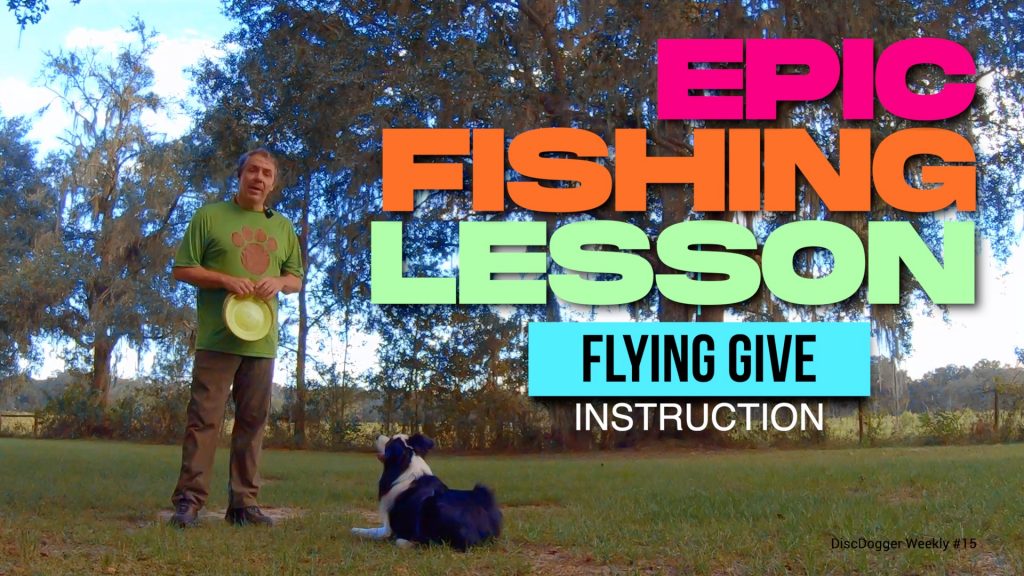
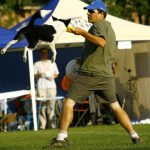

Responses